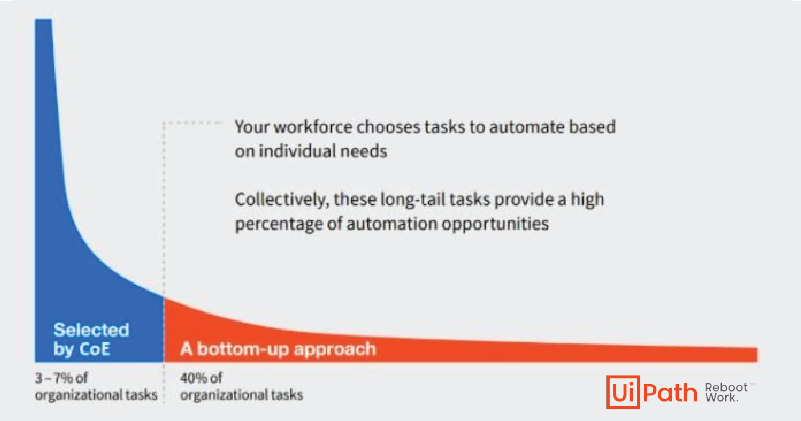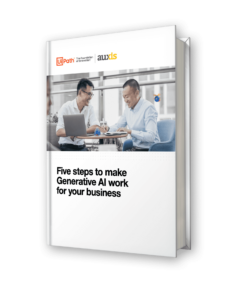From creating invoices to filling out timesheets, every employee loses valuable time every day performing tedious tasks that could be resolved through Robotic Process Automation (RPA).
Automating those activities could significantly improve employee productivity and satisfaction – and often, customer satisfaction by speeding work and response times. But unfortunately, many mundane tasks fail to deliver ROI that justifies prioritization in an automation pipeline because they only benefit single or small groups of employees.
In this article we will lay out what citizen led development means and why your organization needs it in order to achieve “hyperautomation” at scale.
What is a citizen developer?
Citizen developers are non-technical users trained to navigate pre-approved, no-code tools like UiPath’s StudioX to create simple automations for themselves and their departments. In line with its vision of “a robot for every person,” UiPath launched StudioX to empower business users to automate tasks that make their lives easier but don’t fit the criteria for a company-wide program.
With minimal training, citizen developers can significantly reduce backlog and frustration by automating processes and solving work challenges that rank low on their CoE’s list of priorities.
Citizen RPA developers hold the key to advancing enterprise automation and digital transformation on a global scale. As the people in the weeds, they have the power to identify simple processes ripe for automation. They can also solve problems in ways that may not be obvious to developers who aren’t experts in day-to-day operations.
Once a business has RPA running smoothly through its Center of Excellence (CoE), leveraging citizen developers can play a breakthrough role in unlocking a new level of efficiency, agility, and resiliency.
From automation to hyperautomation in six critical steps
Optimally, the journey to company-wide hyperautomation involves six critical steps:
Step 1: CoE-driven automation for the company at large.
RPA journeys typically start with a top-down approach, with a centralized CoE using unattended bots to solve well-known bottlenecks. Automations are chosen based on their potential for delivering huge impact and ROI.
Step 2: CoE-driven attended automation.
Digital transformation accelerates with CoEs providing attended bots that work alongside human workers on their desktops.
Step 3: Employees embrace RPA.
Using automation helps employees realize its benefits and shatters natural skepticism about new technology. As excitement builds, employees want more – and start sharing ideas for other processes to automate.
Step 4: CoE turns employee ideas into automation.
However, with limited time and resources, the CoE must analyze automation ideas and prioritize the ones with the biggest ROI. Without citizen developers, the cycle stops here – and many automations that can significantly improve employees’ work life are never realized.
Step 5: The breakthrough moment.
Citizen developers are empowered to build automation ideas the CoE can’t deliver to improve their workflows.
For instance, an accountant spends an hour every day extracting data from various sources and plugging it into a spreadsheet for reconciliation. Automating that process for one person will never create a solid business case for a CoE. But if that accountant could automate the process on his or her own, investing six hours on StudioX to save an hour every day is a no-brainer.
The CoE checks and governs citizen developer automations to ensure they are safe and secure, making necessary tweaks and assessing whether each automation can benefit others.
Step 6: CoE delivers citizen developer automations to other employees.
Employee-built automations with greater applications are delivered to multiple desktops on a small – and occasionally broader – scale. At global market research firm Nielsen, for instance, a citizen developer-built bot is now being used by 3,000 employees!
The challenges of scaling automation disappear as the cycle sustains itself and everyone is empowered to take part in the company’s digital transformation. The Enterprise Automation Flywheel from UiPath (Figure 1) visually describes how the consumption of automation leads to new ideas for automation, and ultimately how the creation of automations by end users can feed the program and spin the flywheel even faster.
.png)
Figure 1 – Enterprise automation flywheel
Why you need citizen developers to maximize automation potential
Citizen development has generated great hype in the IT world in recent years, and it’s easy to understand why. Gartner reports that 41% of organizations have active citizen development initiatives for various applications – and another 20% are either evaluating or plan to start one.
Webinar Recap
Achieving Hyperautomation with UiPath: Your Roadmap for Scaling RPA the Right Way
In the post-pandemic rush to accelerate digital transformation, UiPath calls citizen development teams “a company’s eyes and ears at the grassroots level” – uncovering automation opportunities that would otherwise go unnoticed or your developers lack the bandwidth to accommodate.
Here are the 3 biggest reasons your company needs a citizen developer model to maximize automation potential:
- Company-wide robots are just the tip of the iceberg. For digital transformation to work, change needs to permeate every layer of an organization. Crowdsourcing automation inspiration leads to faster scaling and speeds how fast personal and department-level automation can be brought online. An added bonus: more RPA evangelists.
- Your CoE can only handle so much. Citizen developers unclog the automation pipeline, helping alleviate pressure on your RPA developers and support employees’ day-to-day work. Professional teams can stay focused on higher-priority automation that requires expert knowledge and simple opportunities important to individuals or departments can quickly reach fruition.
- The people who understand grassroots needs best are the ones performing the processes. Citizen developer initiatives let employees solve their problems before you even realize they exist. They help your organization address what UiPath dubs “the long tail of automation” (Figure 2) – the 40%+ processes that will never be automated without empowering the subject matter experts themselves to eliminate their tedious work.

Figure 2 – A bottom-up approach reaches the long tail of work
Citizen developers democratize automation across an organization – empowering employees to solve their problems before you even realize they exist. Source: UiPath
Governance concerns around citizen development
Uncertainty about citizen development and decentralizing the power of automation generally stems from fear that governance will be lacking. IT leaders voice concerns about compliance issues, not understanding what bots are running and why, and an inability to correct issues if the person who created a bot leaves the company.
The secret to success is striking a balance between empowering non-technical users and ensuring security, quality, and consistency in automations. In the next installment of our citizen developer series, we will share how to establish the governance, controls, and value capture to help you maximize the potential of UiPath citizen development and create a successful enterprise-wide automation.



